Polish Navy
| Polish Navy Marynarka Wojenna | |
|---|---|
|
Polish Navy's Eagle | |
| Active | 1918 - present |
| Country |
|
| Branch | Navy |
| Size | 12,600 military (2016) [1] |
| Part of | Polish Armed Forces |
| Headquarters | Gdynia |
| Engagements |
Standing NRF Maritime Group 1 War in Iraq |
| Commanders | |
| Commander | Admiral Tomasz Mathea |
| Chief of Staff | Vice Admiral Ryszard Demczuk |
| Insignia | |
| Naval Flag |
 |
| Naval Ensign |
 |
| Naval Jack |
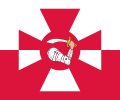 |
The Polish Navy (Polish: Marynarka Wojenna, "War Navy") is the military branch of the Polish Armed Forces responsible for naval operations. The current navy consists of 113 ships (including 5 submarines, 2 frigates, 1 corvette, 3 missile boats - as of 2014) and about 18,000 commissioned and enlisted personnel. The traditional ship prefix in the Polish Navy is ORP (Okręt Rzeczypospolitej Polskiej, "Vessel of the Republic of Poland").
The Polish Navy is one of the largest navies on the Baltic Sea and one of the best equipped. It is mostly responsible for Baltic Sea operations. Other duties include search and rescue operations covering parts of the Baltic, as well as hydrographic measurements and research.
Origins
The Polish Navy has its roots in naval vessels that were largely used on Poland's main rivers in defense of trade and commerce. During the Thirteen Years' War (1454–66), this small force of inland ships for the first time saw real open sea combat. At the battle of Vistula Lagoon, a Polish privateer fleet defeated the Teutonic Knights Navy and secured permanent access to the Baltic Sea. The Second Peace of Thorn (1466) acquired for Poland the strategic naval city of Danzig (Gdańsk), and with it the means of maintaining a large fleet on the Baltic. In 1561, following a victory over Russian Naval forces in the Baltic, the Polish Navy acquired a second key port at Riga, in modern-day Latvia.
At that time, as the Kingdom of Poland and the Grand Duchy of Lithuania became involved in conflicts in Livonia, Polish king Sigismund II Augustus organized a Sea Commission (Komisja Morska) operating in the years 1568-1572 and supported the operations of privateers, but that met with opposition of the Poland's primary port, Gdańsk (Danzig), which saw them as a threat to its trade operations (see Hanseatic League).[2] This led to the development of a privateer port in Puck.[2]
Around the start of the 17th century, Poland became ruled by the House of Vasa, and was involved in a series of wars with Sweden (see also dominium maris baltici).[2] Vasa kings attempted to create a proper fleet, but their attempts met with repeated failures, due to lack of funds in the royal treasury (Polish nobility saw little need for the fleet and refused to raise taxes for its construction, and Gdańsk continued its opposition to the idea of a royal fleet).[2] During the reign of Sigismund III of Poland, the most celebrated victory of the Commonwealth Navy took place at the Battle of Oliwa in 1627 against Sweden, during the Polish–Swedish War. The victory over Sweden secured for Poland permanent access to the Atlantic, and laid the foundations for expeditions beyond Europe. The plans for the independent fleet fell through shortly afterwards due to a badly executed alliance with the Habsburgs who in 1629 took over the fleet.[2]
The Commission of Royal Ships (Komisja Okrętów Królewskich) was created in 1625. This commission, along with the ultimate allocation of funds by the Sejm in 1637, created a permanent Commonwealth Navy. Władysław IV Vasa, Sigismund's son and successor who took the throne in 1632, purchased 12 ships and built a dedicated port for the royal navy called Władysławowo.[2] The Fleet, however, was entirely destroyed in 1637 by Denmark, without a declaration of war.[3] Support for this navy was weak and it largely withered away by the 1640s; the remaining ships were sold in the years 1641-1643, which marked the end of the Commonwealth Navy.[2] A small privateer navy was also created by Augustus II the Strong in 1700 during the Great Northern War.[4]
The Duchy of Courland, by the time a fief of the Kingdom of Poland and the Polish–Lithuanian Commonwealth, had a strong navy: it established colonies on Tobago island in the West Indies (named New Courland) and on the estuary of the Gambia River.
The Polish–Lithuanian Commonwealth, though the dominant force in Central and Eastern Europe during the 16th-18th centuries, never developed its navy to its full potential. The proportionally small Polish coastline and the limited access to the Atlantic never allowed for a massive buildup of naval forces to the level of colonial powers such as England and France. The Partitions of Poland at the end of the 18th century brought an end to the independent Polish Navy.
20th century
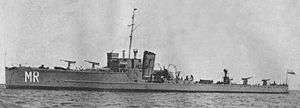
Following World War I, the Second Polish Republic on 28 November 1918, by the order of Józef Piłsudski, commander of the Armed Forces of Poland, founded the modern Polish Navy. The token naval force was placed under the command of Captain Bogumił Nowotny as its first chief. The first ships were acquired from a division of the Imperial German Navy (because of Great Britain's politics, it was very small part, limited to six torpedo boats).
In the 1920s and 1930s the Polish Navy underwent a modernisation program under the leadership of Vice-Admiral Jerzy Świrski (Chief of Naval Staff) and Rear-Admiral Józef Unrug (CO of the Fleet). A number of modern ships were built in France, the Netherlands, and the United Kingdom. Despite ambitious plans (including 2 cruisers and 12 destroyers), the budgetary limitations placed on the government by the Great Depression never allowed the navy to expand beyond a small Baltic force. The building of one submarine, ORP Orzeł, was partly funded by a public collection. One of main goals of the Polish Navy was to protect the Polish coast against the Soviet Baltic Fleet, therefore it put emphasis on fast submarines, large and heavily armed destroyers and mine warfare. By September 1939 the Polish Navy consisted of 5 submarines, 4 destroyers, big minelayer and various smaller support vessels and mine-warfare ships. This force was no match for the larger Kriegsmarine, and so a strategy of harassment and indirect engagement was implemented.
World War II
.jpg)
The outbreak of World War II caught the Polish Navy in a state of expansion. Lacking numerical superiority, Polish Naval commanders decided to withdraw main surface ships to Great Britain to join the Allied war effort and prevent them from being destroyed in a closed Baltic (the Peking Plan). On August 30, 1939, 3 destroyers (ORP Błyskawica, ORP Grom, and ORP Burza) sailed to the British naval base at Leith in Scotland. They then operated in combination with Royal Navy vessels against Germany. Also two submarines managed to flee from Baltic through the Danish straits to Great Britain during the Polish September Campaign (one of them, ORP Orzeł, made a daring escape from internment in Tallinn, Estonia, and traveled without maps). Three submarines were interned in Sweden, while remaining surface vessels were sunk by German aircraft.
 |
| Polish Armed Forces |
|---|
| Branches |
|
|
| History |
|
Timeline Wars |
| Personnel |
|
Senior officers Rank insignia Awards Oaths |
| Equipment |
|
Land Forces Navy |
During the war the Polish Navy in exile was supplemented with leased British ships, including two cruisers, seven destroyers, three submarines, and a number of smaller fast-attack vessels. The Polish Navy fought alongside the Allied navies in Norway, the North Sea, the Atlantic and the Mediterranean, and aided in the escort of Atlantic and Arctic convoys, in which ORP Orkan was lost in 1943. Polish naval vessels played a part in the sinking of the Bismarck, and in the landings in Normandy during D-Day. During the course of the war, one cruiser, four destroyers, one mine layer, one torpedo boat, two submarines and some smaller vessels (gunboats, mine hunters etc.) were sunk; in total, twenty-six ships were lost, mostly in September 1939. In addition to participating in the Bismarck sinking, the Polish Navy sank an enemy destroyer and six other surface ships, two submarines and a number of merchant vessels.
Operations
The following selection illustrates the breadth of Polish Naval activity.
- Peking: evacuation from Poland (September, 1939)
- Worek: submarine defensive blockade of the Polish coast (September, 1939)
- Narvik: battling General Dietl's forces during the Norwegian Campaign (April–June, 1940)
- Dynamo: evacuation of Allied troops from Dunkirk conducted (May/ June, 1940)
- Halberd: Malta convoy (1941)
- Bismarck: sinking of the Bismarck (May 26–27, 1941)
- Anklet: British Commando raid on the Lofoten Islands, Norway (November, 1941)
- Harpoon: Malta convoy (mid-June 1942)
- Jubilee: attack on the German-occupied port of Dieppe, France (August 19, 1942)
- Torch: Anglo-American invasion of French North Africa (November, 1942)
- Husky: Allied invasion of Sicily (July 1943)
- Baytown: landings in Calabria, Italy (September 1943)
- Avalanche: landings near Salerno, Italy (September 1943)
- Alacrity: Allied naval patrols around Azores (1943)
- Shingle: Allied landing in the Anzio area, Italy (January, 1944)
- Tungsten: Fleet Air Arm attack on Tirpitz (April 1944)
- Croquet: Allied anti-shipping patrol off Norway (1944)
- Potluck: Allied anti-shipping patrol off Norway (1944)
- Neptune: the landing phase of Operation Overlord (June 1944)
- Dragoon: Allied invasion of southern France (August 1944)
- Deadlight: scuttling of surrendered U-boats after World War II (late 1945/ early 1946)
Postwar
After World War II, on July 7, 1945, the new Soviet-imposed Communist government revived the Polish Navy with headquarters in Gdynia. During Communist times, Poland's Navy experienced a great buildup, including the development of a separate amphibious force of Polish Marines. The Navy also acquired a number of Soviet-made ships, including 2 destroyers, 2 missile destroyers, 13 submarines and 17 missile boats. Among them was a Kilo-class submarine, ORP Orzeł and a modified Kashin-class missile destroyer, (ORP Warszawa). Polish shipyards produced mostly landing craft, minesweepers and auxiliary vessels. The primary role of the Warsaw Pact Polish Navy was to be Baltic Sea control, as well as amphibious operations along the entire Baltic coastline against NATO forces in Denmark and West Germany. The collapse of the Soviet Union, the dissolution of the Warsaw Pact, and the fall of Communism ended this stance.
21st century
Poland's entrance into the North Atlantic Treaty Organization has greatly changed the structure and role of the Polish Navy. Whereas before, most of Naval High Command was concerned with coastal defense and Baltic Sea Operations, the current mindset is for integration with international naval operations. The focus is on expansion of subsurface naval capabilities, and in the creation of a large submarine force. To facilitate these changes the Republic of Poland has undertaken a number of modernization programs aimed at creating a force capable of power projection around the world. This includes a number of foreign acquisitions, including the acquisition of four Kobben-class submarines from Norway, and two Oliver Hazard Perry-class frigates from the United States. The Polish Navy has also one Kilo-class submarine (ORP Orzeł). The Naval air arm has also acquired a number of SH-2G Super Seasprite helicopters. Highly appreciated is a naval commando unit Formoza (since 2007 part of the Wojska Specjalne).
The Polish Navy has taken part in numerous joint force operations. In 1999 the naval base at Gdynia became the home base of all NATO submarine forces in the Baltic, codenamed "Cooperative Poseidon". That same year joint American-Polish submarine training manoeuvres codenamed "Baltic Porpoise" for the first time utilized the port in a multinational military exercise.
Modernization in 2018
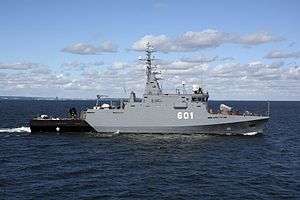
The Polish Navy is undergoing a full modernization. Initially planned as a 9 billion zloty project, the budget was reduced to 5 billion zloty in 2012 which caused projects delays or cancellations over the allotted time 2010 - 2018.[5] The latest strategy for the navy considers larger warships as unsuitable for the Baltic Sea, however one Oliver Hazard Perry-class frigate will be upgraded to extend its operation life beyond 2020. 12 new ships worth around 10 billion PLN were to be acquired before 2026. The plan was updated in 2017 for 2013-2022 period to be worth 13 billion zloty and call to acquire 22 new vessels.[6] This include three Coastal Defence Vessel, code name Miecznik with displacement of 2600 tons, three patrol/mine countermeasure vessel, code name Czapla with 1700 tons displacement.[7][8] Three new submarines are planned with delivery expected in 2024-2025. Three Kormoran 2-class minehunter are planned.[9][10] Other purchases include six tugboats, two tankers, two rescue ships, one ELINT, one logistical support ship and one Joint Support Ship. However some deliveries are expected up to 2026.[6] Meanwhile, to reduce costs, serving vessels will be upgraded and overhauled to maintain operational status. Concerns have been risen about the Polish Navy, as more vessels are being withdrawn from service without being replaced in the near future.[11][12] With the increased tension in the area surrounding Poland, plans have been put in place to potentially procure up to 3 new submarines with cruise missile launch capability. The cruise missiles carried are planned to have an 800 km range.[13]
In late March 2017, Michał Jach, the chairman of the National Defence Committee in the Polish parliament, suggested that the Polish Navy could buy two Adelaide-class frigates from the Royal Australian Navy. The Polish government has formally expressed their intentions to the Australian government.[14][15]
The Polish Navy has already acquired 36 Swedish RBS15 Mk3.[16] and 50 (50/74) Norwegian Naval Strike Missiles[17] for vessels and coastal defence units. It is planned to reinforce the Navy's helicopter fleet with four to eight ASW/SAR units.[18] The Gawron-class corvettes program has been cancelled with sole surviving unit to be built as a patrol vessel.[5] On 2 July 2015 ORP Ślązak was christened during official launching ceremony, becoming the first new Polish-built Navy ship in 21 years.[19] In June 2013 the Coastal Missile Division (NDR) equipped initially with 12 Naval Strike Missiles and two TRS-15C radars achieved initial readiness.[20]
Naval colors
The flag of the Polish Navy is a red flag with the emblem of the Polish Armed Forces – Navy on the foreground. The Naval Emblem has an anchor to distinguish it from other Armed Forces branches. It is traditionally flown on naval bases on land, and at the headquarters of naval command in Gdynia.
The naval jack of the Polish navy is based on a traditional 17th Century fighting jack design of a scimitar ready to strike at the enemy. It was first used during the battle of Oliwa in 1627 against Sweden, during the Polish-Swedish War. It is traditionally flown from the bow of the ship, with the ensign at the stern, when in port. The jack used before 1955 and in 1960–93 was similar, but the armed hand was in flesh colour, with blue sleeve. In 1955–59 a different jack was used.
|
|
|
Organization and mission
_(09).jpg)

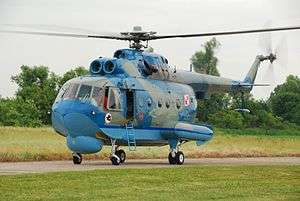
.jpg)

The Polish Navy is organized into 2 separate flotillas, and a Naval Air Brigade, reporting to the Commander-in-Chief of the Polish Navy.[21]
- Operational Headquarters of the Armed Forces in Warsaw
- Maritime Operations Center - Marine Component Command in Gdynia
- General Command of the Armed Forces in Warsaw
- 3 Flotilla Boats in Gdynia
- Submarine Squadron in Gdynia
- Squadron of Battle Battles in Gdynia
- Support Division in Gdynia
- Hydrographic Security Squadron in Gdynia
- Group of Reconnaissance Boats in Gdynia
- Coastal Rocket Squadron in Siemirowice
- Naval Security Branch in Gdynia
- 9th anti-aircraft squadron in Ustka
- 43 sapper battalions in Rozewie
- Command of the Port of War in Gdynia
- Hel's Hel Helvet
- Naval Technical Base in Gdynia
- 8 Coast Defense Flotilla in Swinoujscie
- 2nd Division of Transport and Minor Ships in Swinoujscie
- 12th Division of Trałowców in Swinoujscie
- 13th Division of Trałowców in Gdynia
- 8 MW Bombardment Battalion in Dziwnów
- 8th anti-aircraft squadron in Dziwnów
- Commander of the War Port in Swinoujscie
- Command Point of Naval Point in Kołobrzeg
- Naval Aviation Brigade in Gdynia
- 43 Maritime Aviation Base in Gdynia
- 44 Maritime Aviation Base in Siemirowice
- Information Center for Naval Information and Naval Support in Wejherowo
- 7 Area of Observation and Communications in Hel
- 8 Area of Observation and Communications in Swinoujscie
- Department of Computer Science in Gdynia
- Naval Hydrographical Office in Gdynia
- 6 Radio Broadcasting Center in Gdynia
- Navy Training Center in Ustka
- Naval Officer School in Ustka
- Diving and Scuba Diving Training Center of the Polish Army in Gdynia
- Navy Sailing Training Center in Gdynia
- Navy Club "Riviera" in Gdynia
In addition to this the Polish Navy supplies nearly 40 ships as part of the NATO Rapid Reaction Force, designed to be a force projection and conflict response force around the world. The main mission of the Polish Navy is the defense of Polish territorial waters, the Polish coastline, and Polish interests abroad. Secondary roles include the support of NATO allied operations, such as in the Middle East, and search and rescue operations throughout the Baltic Sea.
Commander-in-Chief of the Polish Navy
The current Commander-in-Chief is Vice Admiral Tomasz Mathea[22] Previous Commanders include
- Roman Krzyżelewski - October 2003 to November 2007
- Andrzej Karweta - November 2007 to April 2010
Ships and naval aircraft
The ship is a Navy vessel carrying its Navy flag, commanded by a Naval Officer registered as an officer with a crew subject to military discipline. Navy ships are subject only to the authorities of the Commonwealth and have immunity. Except for the exceptions indicated in the provisions of international law ratified by the Republic of Poland, no authority of a foreign state can intervene in or interfere in the conduct of domestic acts of a marshal. Any attempts at interfering with the ship should be resolutely rescinded, and in the event of a threat to the life of the crew or a serious violation of the immunity of the ship, the Rules of Engagement should be followed and the rules of international law. Exception is a contribution to allied forces in relation to which Allied documents apply, provided that they do not conflict with national laws. On foreign territorial waters, territorial seas and in economic zones and in foreign ports, MW vessels are required to comply with the local coastal state regulations.
| Name | Unit number | Type | Photo | In service of | Notes | ||||||
|---|---|---|---|---|---|---|---|---|---|---|---|
| Frigates | |||||||||||
| ORP Gen. K. Pułaski[23] | 272 | Oliver Hazard Perry | | 2000 | Ex US Navy | ||||||
| ORP Gen. T. Kościuszko[23] | 273 | Oliver Hazard Perry | | 2002 | Ex US Navy | ||||||
| Corvette | |||||||||||
| ORP Kaszub[24] | 240 | proj. 620 | 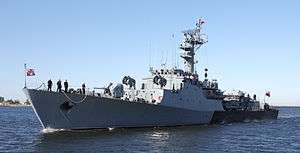 | 1987 | |||||||
| Patrol Vessel | |||||||||||
| ORP Ślązak | 241 | proj. 621M | .jpg) | Built on Stealth technology, on the hull of the unfinished Corvette of the Gawron Corvette. Launched on July 2, 2015. Planned entry into service in 2017. | |||||||
| Missile ships | |||||||||||
| ORP Orkan[25] | 421 | Orkan | | 1992 | |||||||
| ORP Piorun[25] | 422 | Orkan | | 1994 | |||||||
| ORP Grom[25] | 423 | Orkan | | 1995 | |||||||
| Submarines | |||||||||||
| ORP Orzeł | 291 | proj. 877 Paltus (NATO: Kilo) | | 1986 | |||||||
| ORP Bielik | 296 | Kobben | 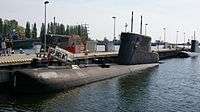 | 2002 | Raising the Polish flag: September 8, 2003. Dehydrated on January 27, 1967 | ||||||
| ORP Kondor | 297 | Kobben | .jpg) | 2002 | Raising the Polish flag: October 20, 2004. Deactivated on June 16, 1964. | ||||||
| ORP Sokół | 294 | Kobben | | 2003 | Raising the Polish flag: June 4, 2002. Launched on 02.09.1966 | ||||||
| ORP Sęp | 295 | Kobben | .jpg) | 2003 | Podniesienie polskiej bandery: 16 sierpnia 2002 roku. Zwodowany 24.03.1966 r. | ||||||
| Mines destroyers | |||||||||||
| ORP Kormoran (2015) | 601 | proj. 258 (Kormoran II) |  | 2016 | Launched on September 4, 2015. Planned build of two more Kormoran II units. | ||||||
| ORP Flaming | 621 | proj. 206FM (Mewa) | | 1966 | |||||||
| ORP Mewa | 623 | proj. 206FM (Mewa) | | 1967 | |||||||
| ORP Czajka | 624 | proj. 206FM (Mewa) | .jpg) | 1967 | |||||||
| Minesweepers | |||||||||||
| ORP Gopło | 630 | [[proj. 207DM (Gopło) | | 1982 | |||||||
| OORP Gardno, Bukowo, Dąbie, Jamno, Mielno, Wicko, Resko, Sarbsko, Necko, Nakło, Drużno, Hańcza | 631–642 | projekt 207P (Gardno) | | 1984-1991 | |||||||
| OORP Mamry, Wigry, Śniardwy, Wdzydze | 643–646 | proj. 207M (Mamry)]] | | 1992-1994 | |||||||
| Okręty transportowo-minowe | |||||||||||
| ORP Lublin | 821 | Proj. 767 Lublin |  | 1989 | |||||||
| ORP Gniezno | 822 | proj. 767 Lublin | .jpg) | 1990 | |||||||
| ORP Kraków | 823 | proj. 767 Lublin |  | 1990 | |||||||
| ORP Poznań | 824 | proj. 767 Lublin | | 1991 | |||||||
| ORP Toruń | 825 | proj. 767 Lublin |  | 1991 | |||||||
| Logistics Support Ships | |||||||||||
| ORP Kontradmirał Xawery Czernicki | 511 | proj. 890 | .jpg) | 2001 | |||||||
| Tankers | |||||||||||
| ORP Bałtyk | Z-1 | proj. ZP-1200 | | 1991 | |||||||
| Ships radio recognition | |||||||||||
| ORP Nawigator | 262 | proj. 863 (Nawigator) | 1975 | ||||||||
| ORP Hydrograf | 263 | proj. 863 (Nawigator) | | 1976 | |||||||
| SAR ships | |||||||||||
| ORP Piast | 281 | proj. 570 (Piast) | | 1974 | |||||||
| ORP Lech | 282 | proj. 570 (Piast) | | 1974 | |||||||
| ORP Zbyszko | R-14 | proj. 5002 (Zbyszko) | 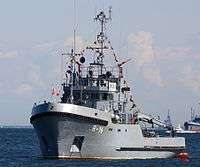 | 1991 | |||||||
| ORP Maćko | R-15 | proj. 5002 (Zbyszko) |  | 1992 | |||||||
| Hydrographic vessels | |||||||||||
| ORP Heweliusz | 265 | proj. 874 (Heweliusz) | | 1982 | |||||||
| ORP Arctowski | 266 | proj. 874 (Heweliusz) | | 1982 | |||||||
| Training ships | |||||||||||
| ORP Iskra | 253 | proj. B79/II | | 1982 | |||||||
| ORP Wodnik | 251 | okręty szkolne typu Wodnik | .jpg) | 1976 | Museum ships | ||||||
| ORP Błyskawica | H34 | Grom |  | 1937 | In line service until 1975, ship museum since 1976. | ||||||
Aircraft
| Aircraft | Origin | Type | Variant | In service[26] | Notes |
|---|---|---|---|---|---|
| Special Mission | |||||
| PZL M28B Bryza 1R | Poland | Maritime Patrol | M-28 | 9 | |
| Transport | |||||
| PZL M28 Skytruck | Poland | Transport | M-28 | 4 | |
| Helicopter | |||||
| Mil Mi-2 | Poland | Command & Utility | Mi-2 | 4 | |
| Mil Mi-8/17 | Soviet Union | Transport | Mi-17 | 2 | |
| Mil Mi-14 | Soviet Union | ASW SAR |
Mi-14PŁ Mi-14PŁ/R |
4 2 |
To be replaced by 8 ASW/SAR units.[27] |
| SH-2G Super Seasprite | USA | ASW | SH-2G | 4 | |
| PZL W-3 Sokół | Poland | SAR | W-3WARM W-3RM W-3T/SAR |
3 3 2 |
2 W-3T upgraded to W-3WARM |
 Mil Mi 8/17
Mil Mi 8/17- Mil Mi-14PŁ
.jpg) Mil Mi-14PŁ/R
Mil Mi-14PŁ/R Kaman SH-2G Super Seasprite
Kaman SH-2G Super Seasprite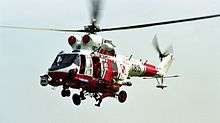 W-3RM Anakonda
W-3RM Anakonda M-28B Bryza-1TD
M-28B Bryza-1TD.jpg) M-28B Bryza-1RM bis
M-28B Bryza-1RM bis
See also
- Polish Armed Forces rank insignia
- List of ships of the Polish Navy
- Polish contribution to World War II#Navy
- Polish Merchant Navy
- Polish Navy order of battle in 1939
Notes
- ↑ http://www.bip.mon.gov.pl/pliki/file/wersja%20polska.ppt
- 1 2 3 4 5 6 7 Juliusz Bardach, Boguslaw Lesnodorski, and Michal Pietrzak, Historia panstwa i prawa polskiego (Warsaw: Paristwowe Wydawnictwo Naukowe), 1987, p.231
- ↑ Michael Roberts (27 April 1984). The Swedish Imperial Experience 1560-1718. Cambridge University Press. pp. 16–17. ISBN 978-0-521-27889-8. Retrieved 7 June 2011.
- ↑ Jerzy Pertek Polacy na morzach i oceanach: Do roku 1795, p. 176
- 1 2 "Rozczarowujące BME 2010". Altair. Retrieved 2012-04-17.
- 1 2 Nowy harmonogram modernizacji MW RP. Altair, January 20th, 2017. (in Polish)
- ↑ The Polish Navy Development Concept. amberexpo.pl
- ↑ Miecznik i Czapla częściowo odtajnione. Altair (in Polish)
- ↑ TECHNICAL MODERNIZATION PLAN FOR ARMED FORCES in the years 2013-2022. (in Polish)
- ↑ "Polish Navy to Acquire New Submarine". Defense News. Retrieved 14 December 2014.
- ↑ "Gawron na wodzie". Altair. Retrieved 2012-04-17.
- ↑ "ORP Pułaski – pływający złom". Altair. Retrieved 2012-04-17.
- ↑ "Rakiety dla samolotów, okrętów i wyrzutni naziemnych. Polska armia ostrzy kły". TVN24.pl. Retrieved 14 December 2014.
- ↑ Adamowski, Jaroslaw (29 March 2017). "Poland eyes frigates from Australia, new submarines". Defense News. Warsaw, Poland. Retrieved 14 April 2017.
- ↑ Kerr, Julian (30 March 2017). "Ex-RAN FFGs for Poland?". Australian Defence Magazine. Sydney, Australia. Retrieved 14 April 2017.
- ↑ "RBS15 Mk 3 Surface to Surface Missile SSM in use". Saab Group. Archived from the original on October 24, 2010.
- ↑ "defence.professionals". defpro.com. Retrieved 2012-04-17.
- ↑ "Poland evaluates three bids for helicopter acquisition". Retrieved 2017-04-08.
- ↑ Defence Minister: We need to expand Polish Navy. 02.07.2015
- ↑ "Ukompletowanie NDR". Altair.
- ↑ "Polish Navy". Retrieved 14 December 2014.
- ↑ "Polish Navy". Retrieved 14 December 2014.
- 1 2 "Oliver Hazard Perry" (in Polish). www.mw.mil.pl. Retrieved 2012-05-29.
- ↑ "ORP Kaszub" (in Polish). www.mw.mil.pl. Retrieved 2012-05-29.
- 1 2 3 "Małe okręty rakietowe typu ORKAN" (in Polish). www.mw.mil.pl. Retrieved 2012-05-29.
- ↑ "World Air Forces 2016". Flightglobal International. Flightglobal International. December 2015. Retrieved 29 April 2016.
- ↑ Poland speeds acquisition of 16 helicopters.
References
- Michael Alfred Peszke, Poland's Navy: 1918–1945, New York, Hippocrene Books, 1999, ISBN 0-7818-0672-0.

.svg.png)

